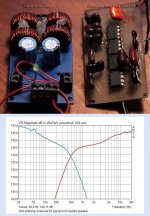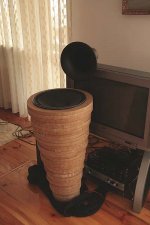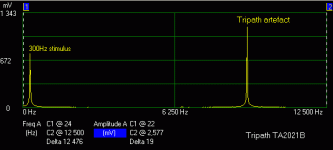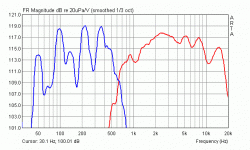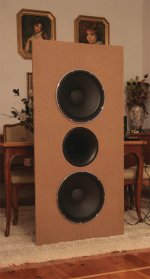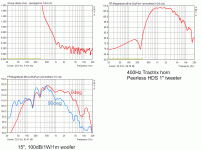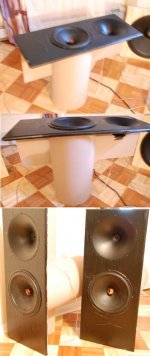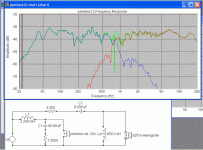jzagaja, what woofer are you going to use with these?
your crossover point is really low. you may use some 15-18in woofers for an ultimate two way speaker 🙂
your crossover point is really low. you may use some 15-18in woofers for an ultimate two way speaker 🙂
nice woofers! what amp are you going to use with them?
I just replaced my amp6 with ucd180, it sounds so much better.
woofers need a lot of power, even if they are efficient.
for tweeters t-amp appears to be sufficient(I don't listen too loud).
there is interesting effect with these waveguides, if properly positioned, they create an impression that singer's head has size of the wall and all instruments are huge.
I just replaced my amp6 with ucd180, it sounds so much better.
woofers need a lot of power, even if they are efficient.
for tweeters t-amp appears to be sufficient(I don't listen too loud).
there is interesting effect with these waveguides, if properly positioned, they create an impression that singer's head has size of the wall and all instruments are huge.
I'm using Tripath TA2021B chip amp. With shelving lowpass filter it seems there isn't much headroom - I've got clipping. I have one problem - efficiency mismatch. Waveguide amplifies 93dB tweeter by +10dB but in reality woofer is 8dB down. I'm not sure why. Driver just lies on the enclosure without sealing. With this arrangement ceiling and floor reflections cancel out 150 and 300Hz by 10dB.
When sound source are to big then you have time domain artefact. Whit horns it is common. It's nice but not correct.
I've got nice artefact from Tripath - 300Hz tone appended.
When sound source are to big then you have time domain artefact. Whit horns it is common. It's nice but not correct.
I've got nice artefact from Tripath - 300Hz tone appended.
Attachments
Today I've installed voltage divider on HP output (1k, 2k2 = 6.8dB attenuation). Now the sensitivity is average and both drivers more or less equal in levels. Sound becomes interesting - quite close to the life performance. Vibes for example from Manger sampler are rendered faithfully for the first time - I know them very well from Kassel and Wolfgang Lackerschmid concerts. Bass amount is more than necessary. - very short and dynamic, no overhang and wind like from bass reflex and small monitors. Next move is to check 1000Hz XO frequency where woofer becomes directional. My horn looses efficiency off axis and below 1kHz. Notice a handbook amount of modes when woofer is firing upwards.
Attachments
do you think that time domain artifact (huge singers effect)can be caused by floor/wall reflections? it doesn't bother me, I actually like it. it disappears when I put speakers closer together.
your woofer's responce has similar ripples as mine.
I guess it's all caused by room reflections.
is woofer's responce measured 90 degrees off axis?
your woofer's responce has similar ripples as mine.
I guess it's all caused by room reflections.
is woofer's responce measured 90 degrees off axis?
A huge singers effect is definitely room reflection then probably mouth diffraction and then time alignment (check BD design horns - Lowther+Tractrix=big sound sources). After heard Manger transducer I'm sure that single spike, single rise curve of an impulse response is important for spatial localisation natural sound source size. It can be optimized IMHO with oscilloscope and square pulse stimulus. That's why my woofer fires upwards (room reflections) and horn lies on it for fine tuning.
I've got serious problem with lowpass section of my active crossover. Nedded +15dB at 30Hz pushes commercial amps out of rails. Special power amp is needed or attenuator. Also 1kHz dividing frequency formed large 10dB dip so two drivers didn't add properly. Don't know why. RAW horn holds pressure up to 600-700Hz off axis. I prefer to cross as low as possible because of enclosure arrangement. Acoustical centre was detected at ca. 15"/2 woofer radius using oscilloscope and 200Hz square stimulus.
why do you need +15db at 30hz? you may convert enclosure to ported, if you want to extended low frequency response.
Monacor SP-15A's fs is 49 hz, and xmax is quite low. so I wouldn't expect super deep bass from them.
have you tried to run woofer without crossover?
maybe try to mount it upside down? it will look interesting.
Monacor SP-15A's fs is 49 hz, and xmax is quite low. so I wouldn't expect super deep bass from them.
have you tried to run woofer without crossover?
maybe try to mount it upside down? it will look interesting.
I'll certainly try upside down arrangement later. Subtractive 4th order crossovers gave me good joining between woofer and horn, on axis. At larger angles crossover bump from LP section is a bit problematic and I prefer toe-in. I worry a bit about woofer breakeup because it rolls slowly. See:
http://www.diyaudio.com/forums/showthread.php?postid=1441542#post1441542
http://www.diyaudio.com/forums/showthread.php?postid=1441542#post1441542
jzagaja, you may instead of attaching that adapter, cut back side of the horn until it flash fit to tweeters' dome. it will be much more shallow and become a waveguide.
unless of course it's super expensive horn and you don't want to mess with it 🙂
unless of course it's super expensive horn and you don't want to mess with it 🙂
Horn throat is 2" and dome is 1" - you'll get terrible high frequencies. It's butter to turn a new OS profile. Max. diameter of my machines is 36cm.
Baffleless speaker is interesting cuz dipoles are huge and cannot satisfy our wifes 😉 Theoretically in-phase connection (bipole) should give quite good quasi infinite baffle but in reality needs disc like enclosure.
At the moment I cooking DSP crossover. High frequency tones are missing eg. condenser mic grain or strings in comparison to headphones. Don't know - soft dome sound (damping) or linear distortion. For optimisation of an active crossover I've chosen 3rd single opamp Bessel (LP) with subtractive HP and some tweaking.
At the moment I cooking DSP crossover. High frequency tones are missing eg. condenser mic grain or strings in comparison to headphones. Don't know - soft dome sound (damping) or linear distortion. For optimisation of an active crossover I've chosen 3rd single opamp Bessel (LP) with subtractive HP and some tweaking.
Dear Audio Experts,
Forget about cookbook crossover filters for a moment. Is it possible to join below horn loaded tweeter with woofer firing upwards (blue colour)? For example I can run CALSOD optimizer but it assumes minimum phase approximation over horn response which isn't MP in nature. In other words do I need drivers overlap at least one octave in any case?
Forget about cookbook crossover filters for a moment. Is it possible to join below horn loaded tweeter with woofer firing upwards (blue colour)? For example I can run CALSOD optimizer but it assumes minimum phase approximation over horn response which isn't MP in nature. In other words do I need drivers overlap at least one octave in any case?
Attachments
- Status
- Not open for further replies.
- Home
- Loudspeakers
- Multi-Way
- xt25 in 12in waveguide experiment
